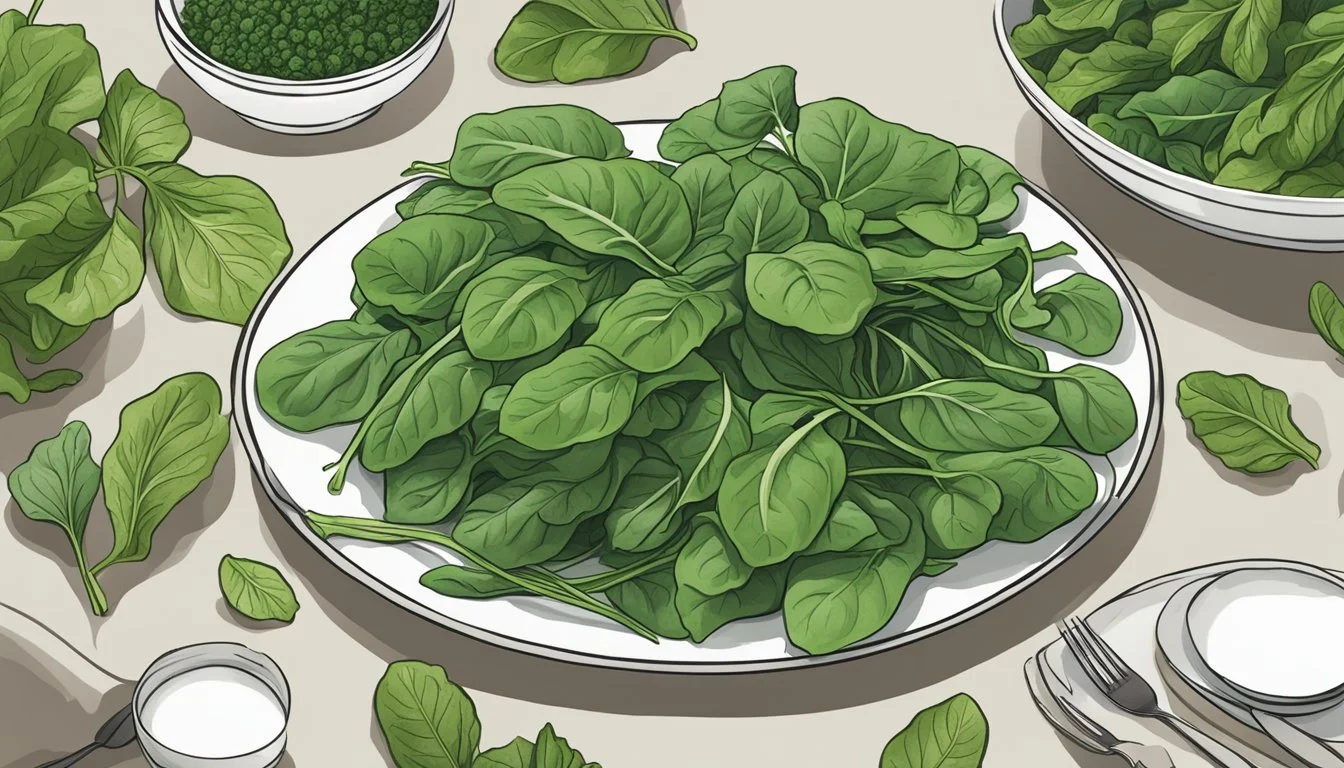New Zealand Spinach Substitutes
Top Alternatives for Your Recipes
For those who crave the vibrant crunch of leafy greens but struggle with spinach in warm climates, New Zealand spinach (Tetragonia tetragonoides) offers a versatile alternative. Known for its resilience in heat and tolerance to salty soils, New Zealand spinach stands out as an excellent spinach substitute. This plant is not a true spinach but shares a similar flavor and nutritional profile, making it perfect for a variety of dishes.
New Zealand spinach thrives where traditional spinach may falter, transforming coastal gardens and hot summer plots into lush green havens. Gardeners and cooks alike will appreciate its adaptability and the fresh, slightly earthy taste it adds to meals. When conventional spinach isn't an option, this green remains a must-grow for anyone committed to incorporating nutrient-rich leafy vegetables into their diet.
Beyond New Zealand spinach, other substitutes like Malabar spinach and Orach (Mountain spinach) also offer unique benefits. These greens provide similar culinary qualities and nutrition, ensuring that health-conscious eaters never have to compromise on their beloved leafy greens, no matter the climate or soil conditions.
Understanding New Zealand Spinach
New Zealand spinach, also known as Tetragonia tetragonoides, is a versatile leafy green. It provides numerous culinary uses and significant nutritional value, making it an excellent addition to any diet. For optimal growth, it requires specific conditions which will be detailed below.
Botanical Profile
New Zealand spinach belongs to the Aizoaceae family, different from regular spinach (Amaranthaceae). It is native to New Zealand and Australia, growing as a perennial in warm climates. The plant has succulent leaves and a weak-stemmed, trailing habit, making it suitable for ground cover in gardens.
Its seeds are quite hardy, often needing soaking before planting to encourage germination. It thrives when spaced adequately in rows to accommodate its spreading nature.
Culinary Uses
New Zealand spinach can be consumed both raw and cooked. Raw, it can be added to salads, providing a crunchy texture. When cooked, it resembles regular spinach and can be used in similar dishes such as soups, stir-fries, and casseroles.
Its mild flavor makes it a staple in various recipes, complementing a wide array of ingredients. Regular trimming of the plant encourages continuous growth, ensuring a steady supply of fresh leaves.
Nutritional Value
This leafy green is rich in vitamins and minerals. It is a valuable source of Vitamin K, Vitamin A, iron, potassium, calcium, and fiber. These nutrients support overall health, aiding in processes such as blood clotting, vision, and bone strength.
Antioxidants present help combat oxidative stress. Additionally, it contains folate, crucial for DNA synthesis and repair, making it particularly beneficial for pregnant women.
Ideal Growing Conditions
New Zealand spinach prefers full sun but can also tolerate partial shade. It thrives in well-drained soil with a pH of 6.0 to 7.0, enriched with organic matter. For optimal growth, maintain soil moisture and avoid waterlogged conditions.
Seeds should be soaked before planting and spaced adequately to allow the plant to spread. Regular harvesting of the tips at 4 inches promotes bushier growth. Store harvested leaves at 35º F with 95-100% humidity to retain freshness.
Popular Spinach Substitutes
Many leafy greens can replace spinach in various recipes, offering differing flavors and nutrient profiles. Swiss chard, kale, amaranth leaves, watercress, and arugula are among the top choices.
Swiss Chard
Swiss chard, from the Beta vulgaris species, is an excellent spinach substitute. Its earthy taste and vibrant colors make it a popular choice in many dishes. Swiss chard is rich in Vitamin C, magnesium, and manganese. The tender leaves and stems can be sautéed, added to soups, or used in salads. Swiss chard holds its texture well during cooking, making it versatile for both fresh and cooked recipes.
Kale
Kale, a member of the Amaranthaceae family, is widely known for its dense nutritional profile. It offers a slightly bitter, earthy flavor that works well in both raw and cooked forms. Kale is packed with vitamins A, C, and K, along with minerals like calcium and magnesium. Its robustness makes it suitable for hearty dishes like stews and casseroles. Massaging kale with olive oil can make it softer and more palatable in salads.
Amaranth Leaves
Amaranth leaves are another nutritious alternative to spinach, belonging to the same botanical family. They feature a slightly earthy and nutty flavor. Amaranth leaves are high in vitamins A and C and minerals such as iron and calcium. These leaves are typically used in soups, stews, and stir-fries. They can also be steamed or added to smoothies for an extra nutrient boost.
Watercress
Watercress has a peppery taste that sets it apart from other leafy greens. This brassica family member is an excellent source of vitamins A, C, and K and contains significant levels of calcium and iron. Watercress is best used fresh, adding a spicy kick to salads and sandwiches. It can also be blended into sauces or cooked briefly in soups to preserve its nutritional value.
Arugula
Arugula, known for its distinctive peppery flavor, is especially popular in salads and as a fresh garnish. This leafy green is rich in vitamins C and K and provides a good amount of calcium and potassium. Arugula's smaller, delicate leaves make it ideal for raw applications, but it can also be wilted slightly in warm dishes like pasta and pizza. Its strong flavor pairs well with milder greens or in combination with other spinach substitutes.
Substitutes for Specific Dishes
When replacing New Zealand spinach in different dishes, consider alternatives that match its taste, texture, and nutritional benefits. Key substitutes include kale, amaranth, and mustard greens, each suiting different culinary applications like salads, soups, pasta dishes, smoothies, and omelets.
Substitutes in Salads
New Zealand spinach brings a mild taste and crisp texture to salads. For similar results, kale can be used, especially in raw form, providing a slightly bitter flavor that complements various dressings. Amaranth leaves offer a tender texture and mild taste, ideal for mixing with other greens. Bok choy adds a hint of pepperiness and crunch, suitable for Asian-inspired salads. These options ensure salads remain nutrient-rich, contributing fiber, vitamins A, C, and K, and antioxidants.
Substitutes in Soups
In soups, New Zealand spinach adds volume and a slightly grassy flavor. Turnip greens or mustard greens can be excellent replacements, adding a peppery taste and dense texture that holds up well during cooking. Swiss chard is another great option, offering a mild flavor and vibrant colors that enhance soups visually and nutritionally. Opt for Kale for a robust texture that doesn't disintegrate easily. These greens ensure soups remain hearty and nutritious with added vitamins and minerals.
Substitutes in Pasta Dishes
Pasta dishes require greens that blend well with sauces. Kale fits perfectly due to its hearty texture and ability to absorb flavors when sautéed. Swiss chard provides a slightly sweet taste and colorful stems, adding visual appeal. Amaranth leaves offer a mild flavor, ensuring they don't overpower the dish. Bok choy can be used for a unique twist, lending a mild bitterness and crunchy base that enhances various pasta recipes. These substitutes keep pasta dishes nutritious and delicious.
Substitutes in Smoothies and Omelets
Smoothies and omelets benefit from greens that blend smoothly or cook quickly. Spinach substitutes like bok choy work beautifully in smoothies, offering a light flavor that pairs well with fruits. Kale adds bulk and a nutrient boost, though its robust flavor might need balancing with sweeter ingredients. For omelets, mustard greens bring a slightly spicy kick, while turnip greens offer a mild, earthy taste. These substitutes maximize vitamin intake and fiber content, making breakfasts healthier and more flavorful.
Cultivation Tips for Home Gardeners
Growing New Zealand Spinach can be a rewarding addition to any home garden. These guidelines cover key aspects like soil preparation, planting, pest control, and harvesting.
Soil Preparation and Maintenance
New Zealand Spinach thrives in well-drained, nutrient-rich soil. Ideal soil should be amended with organic matter such as compost, making it moisture-retentive. A soil pH of 6.8 to 7.0 is optimal. To prepare planting beds, first till the soil to a depth of about 12 inches. Integrate well-aged compost to enrich it.
Raised beds can be beneficial as they prevent waterlogging and improve drainage. It's also essential to keep the soil consistently moist but not soggy, so regular watering is a must.
Sowing and Plant Care
Seeds can be sown directly in the garden after the last frost when the soil is warm. For better germination, pre-soak seeds in water for a few hours before planting. Sow seeds about 3-4 inches apart in rows spaced 12 inches apart. Thin the seedlings to 12 inches apart to allow ample space for growth.
New Zealand Spinach prefers full sun. Use a balanced fertilizer, rich in nitrogen, to promote lush, leafy growth. Trimming the tips when they reach about 4 inches encourages bushier plants and continuous harvest.
Pests and Common Diseases
Aphids and spider mites can attack New Zealand Spinach. Combat them using natural predators like ladybugs or with insecticidal soaps. Regularly inspect the undersides of leaves for these pests.
Diseases such as mildew and leaf spot can be issues in humid climates. Ensure proper spacing and airflow to mitigate these problems. Water the plants at the base to keep the foliage dry and reduce the risk of fungal diseases.
Harvesting and Storage
Harvesting can begin once the plants are well-established and have a decent amount of foliage. Cut the outer leaves first, keeping the central growth intact to encourage new leaves. For best flavor, harvest leaves in the morning.
To store, keep the harvested leaves at about 35°F with high humidity (95-100%). This allows the leaves to stay fresh for up to two weeks. For longer storage, blanch and freeze the leaves.
Growing New Zealand Spinach requires specific care and attention, but with the right conditions and maintenance, it can become a productive crop in your vegetable garden.
Nutritional Comparisons
New Zealand spinach offers a range of vitamins, minerals, and antioxidants, making it a nutritious option. When comparing it to other leafy vegetables like spinach and kale, the differences in essential nutrients become evident.
Comparing Vitamins and Minerals
New Zealand spinach is rich in vitamins and minerals. Vitamin K is notably high, with 525.6 µg per 180 grams. Spinach and kale are also excellent sources of Vitamin K, crucial for blood clotting and bone health.
Iron is another vital mineral, with New Zealand spinach providing 1.19 mg per 180 grams. Regular spinach contains similar levels, making both good choices for iron intake. Magnesium and calcium are also present in significant amounts, supporting various bodily functions such as muscle contraction and nerve signaling.
Dietary Fiber and Protein Content
Dietary fiber is essential for digestive health. New Zealand spinach contains a moderate amount of fiber, contributing to feeling full and aiding digestion. Kale and regular spinach are also high in fiber, often recommended for a balanced diet.
Protein content in New Zealand spinach is lower compared to legumes or grains like quinoa but still provides a modest amount. While not a primary source of protein, it complements other protein sources in a meal. Combinations with foods like quinoa can enhance the overall protein profile of a dish.
Antioxidant Properties
Antioxidants help combat oxidative stress and inflammation. New Zealand spinach contains key antioxidants such as Vitamin C and beta-carotene. Regular spinach is well-known for its high levels of lutein and zeaxanthin, which support eye health.
Kale also stands out with a rich antioxidant profile, including Vitamin C and several flavonoids. These compounds collectively contribute to reducing inflammation and promoting overall health. Anti-inflammatory benefits are particularly significant in maintaining long-term wellness.
By considering these aspects, one can better understand the nutritional benefits of New Zealand spinach and its substitutes, thus enabling informed dietary choices.






